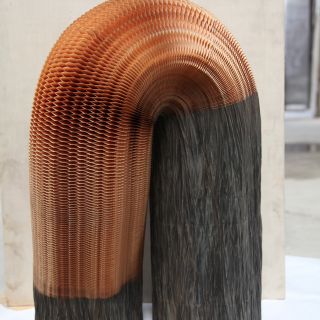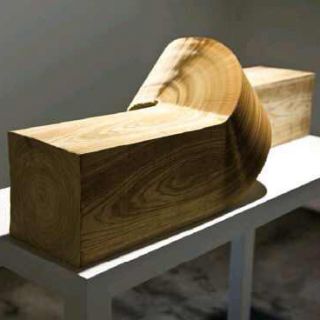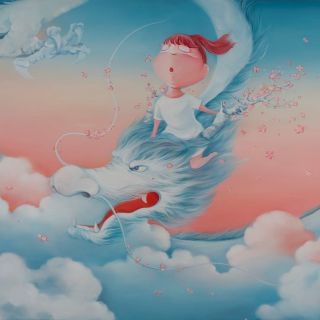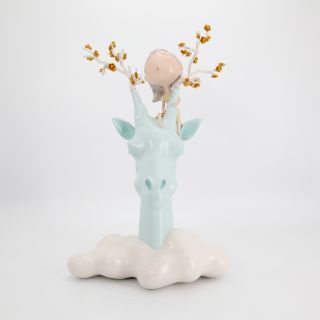
Wang Lei was born in 1980 in Henan, China, and is one of the
most prominent contemporary artists in China. Wang Lei has an eye for intimate details and subtleties. He brings an art piece to life by
absorbing all historical and social factors as a subtle culture within layers of time. We see this not only in the context of his artwork but
also in the process of designing and creating. Wang Lei’s artworks succeed in
its contemporary agenda to communicate with a vast range of audiences from
different backgrounds.
He uses paper and twists it into long, delicate threads which are then woven into reproductions of Chinese robes. The manipulation of this tough-textured paper into the composition of such an exquisite garment highlights the problems surrounding the relationship between viewer perceptions and reality. Wang Lei also draws attention to the often-disputed interconnectedness of traditional and contemporary art, focusing on the reverence for history and tradition as a central obstacle which hinders the acceptance of contemporary art in China.
He uses paper and twists it into long, delicate threads which are then woven into reproductions of Chinese robes. The manipulation of this tough-textured paper into the composition of such an exquisite garment highlights the problems surrounding the relationship between viewer perceptions and reality. Wang Lei also draws attention to the often-disputed interconnectedness of traditional and contemporary art, focusing on the reverence for history and tradition as a central obstacle which hinders the acceptance of contemporary art in China.
Viewing 6 works by Wang Lei
Sort
Biography 
Biography
Exhibitions 
Exhibitions
2019
Chinese Whispers: Recent Art from the Sigg Collection, MAK Austrian Museum of Applied Arts / Contemporary Art, Vienna, Austria
2016
Art Central Hong Kong 2016 Playful Wave: Finding Friends, Today Art Museum, Beijing, China
Breathing – Contemporary Sculptures in Traditional Chinese Culture, Nanjing Museum, China
Three Shadows Photography Award, Three Shadows Photography Center, Beijing, China
2015
13th Art Stays Festival of Contemporary Art, Ptuj, Slovenia
International Watercolour Biennial, Shenzhen, China
2014
“Trigrams,” The National Art Museum of China, Beijing, China
Buddha und die Männer, Gallery Yumachi, Berlin, Germany
Art Basel Miami 2014
2013
Chengdu Biennale, The New International Exhibition Center, Chengdu Inter-Vision, A Contemporary Art Exhibition Across the Straits
National Art Museum of China, Beijing, China; Taiwan Art Museum, Taiwan
Gradualness: 2013 Young Artists Research Exhibition, Today Art Museum, Beijing, China; Wuhan Art Museum, Wuhan, China
Dancing Soul on Paper: Wang Lei's Art Exhibition, International Financial Museum, Beijing, China; Chinese Museum of Funds, Suzhou, China
Lei Wang, Pantocrator Gallery, Beijing, China
2012
Unimaginative: Installation Art Exhibition, Chambers Fine Art, Beijing, China
Second Art Stage Singapore, Marina Bay Sands, Singapore
Starting: China Sculpture Institute Tour for Young Artists, Today Art Museum, Beijing, China
The Conversation: Wang Lei Solo Exhibition, Modern Art Gallery, Taiwan; Found Museum, Beijing, China
Material - Object, Klein Sun Gallery, Chelsea, New York, USA
2011
The Decade of the Rabbit, White Rabbit Collection, Sydney, Australia
Harmonious Differences-Second Experimental Art Exhibition, CAFA Art Museum, Beijing, China
2010
The Start of a Long Journey: 2010 CAFA Excellent Graduation Works Exhibition, CAFA Art Museum, Beijing, China
2008
Art Basel - Miami, Miami, USA
China - Europe Exhibition of Paper Art, Austrian Museum of Paper-making, Steyrermühl, Austria
Chinese Contemporary Art Documents, Wall Art Museum, Beijing, China
2007
My Story - Nominated Award Exhibition of the 5th Light of Academe, CAFA Art Museum, Beijing, China
Chinese Whispers: Recent Art from the Sigg Collection, MAK Austrian Museum of Applied Arts / Contemporary Art, Vienna, Austria
2016
Art Central Hong Kong 2016 Playful Wave: Finding Friends, Today Art Museum, Beijing, China
Breathing – Contemporary Sculptures in Traditional Chinese Culture, Nanjing Museum, China
Three Shadows Photography Award, Three Shadows Photography Center, Beijing, China
2015
13th Art Stays Festival of Contemporary Art, Ptuj, Slovenia
International Watercolour Biennial, Shenzhen, China
2014
“Trigrams,” The National Art Museum of China, Beijing, China
Buddha und die Männer, Gallery Yumachi, Berlin, Germany
Art Basel Miami 2014
2013
Chengdu Biennale, The New International Exhibition Center, Chengdu Inter-Vision, A Contemporary Art Exhibition Across the Straits
National Art Museum of China, Beijing, China; Taiwan Art Museum, Taiwan
Gradualness: 2013 Young Artists Research Exhibition, Today Art Museum, Beijing, China; Wuhan Art Museum, Wuhan, China
Dancing Soul on Paper: Wang Lei's Art Exhibition, International Financial Museum, Beijing, China; Chinese Museum of Funds, Suzhou, China
Lei Wang, Pantocrator Gallery, Beijing, China
2012
Unimaginative: Installation Art Exhibition, Chambers Fine Art, Beijing, China
Second Art Stage Singapore, Marina Bay Sands, Singapore
Starting: China Sculpture Institute Tour for Young Artists, Today Art Museum, Beijing, China
The Conversation: Wang Lei Solo Exhibition, Modern Art Gallery, Taiwan; Found Museum, Beijing, China
Material - Object, Klein Sun Gallery, Chelsea, New York, USA
2011
The Decade of the Rabbit, White Rabbit Collection, Sydney, Australia
Harmonious Differences-Second Experimental Art Exhibition, CAFA Art Museum, Beijing, China
2010
The Start of a Long Journey: 2010 CAFA Excellent Graduation Works Exhibition, CAFA Art Museum, Beijing, China
2008
Art Basel - Miami, Miami, USA
China - Europe Exhibition of Paper Art, Austrian Museum of Paper-making, Steyrermühl, Austria
Chinese Contemporary Art Documents, Wall Art Museum, Beijing, China
2007
My Story - Nominated Award Exhibition of the 5th Light of Academe, CAFA Art Museum, Beijing, China
Critique 
Critique
Wang Lei was born in 1980 in Henan, China, and is one of the most prominent contemporary artists in China. He gained an MA in Arts from the Department of Experimental Art of Central Academy of Fine Arts and currently lives in Beijing and Luoyang. Wang Lei has an eye for intimate details and subtleties. He brings an art piece to life by absorbing all historical and social factors as a subtle culture within layers of time. We see this not only in the context of his artwork but also in the process of designing and creating. Wang Lei’s artworks succeed in its contemporary agenda to communicate with a vast range of audiences from different backgrounds.
This series is based on traditional clothes and costumes during the Ming Dynasty. The routine of donning the uniform was not solely for fashion, but has always been a marker of social status. Wang Lei challenges the costume’s subject matter of taste and class by casting it in a completely different framework. Wang Lei employs materials that have always been defined as non-wearable. Yet, he chooses materials which have meaning that are open to interpretation, based on how people perceive its use. This leads everyone’s thoughts to a paradox, and paradoxes are deeply entangled within our contemporary lifestyles. The duplicities and multiplicities in meaning exist to inform our improvement, growth, comfort and enlightenment. It is within these paradoxes that we seek individualism and attempt to create a new identity. Similarly, in Wang Lei’s art, he weaves paradoxes into the creation of his traditional details and delicate craftwork. The devotional application of his knitting method seemingly disregards the conceptual and reckless approach of his extrapolated artistic inspiration. It is within this dialogue that his artworks may be discussed in a pro-conceptual manner. For example, in his Ming Dynasty Customs series, Wang Lei reproduces one of the famous designs with a completely new material – paper from a Chinese-English dictionary. He tediously knits the paper in an accurate manner such that all the textures and patterns follow the right traditional process. He dedicates himself to this process of creation as he believes that such commitment will raise the concept of his art to a sacred position that will be deemed worthy.
Wang Lei questions the quality of everyone’s approach to the matter of creating a new social identity in this innocuous series of toilet paper cloths. The process of making the artwork with his own hands and the dedication he puts in to knit each one of the cloths accurately, demonstrates how he admires the traditional ways of reproducing time-consuming handmade traditions in different designs, forms, patterns and styles in order to create profound visual conversation. The primary feeling that is evoked when one views Wang Lei’s artworks is the sanctity contained in a delicate piece of handicraft work. As we reflect on this feeling of warmth, it is perhaps a candid recognition of the quality of choices and the background of our customs that define us as a responsible member of our society.
This series is based on traditional clothes and costumes during the Ming Dynasty. The routine of donning the uniform was not solely for fashion, but has always been a marker of social status. Wang Lei challenges the costume’s subject matter of taste and class by casting it in a completely different framework. Wang Lei employs materials that have always been defined as non-wearable. Yet, he chooses materials which have meaning that are open to interpretation, based on how people perceive its use. This leads everyone’s thoughts to a paradox, and paradoxes are deeply entangled within our contemporary lifestyles. The duplicities and multiplicities in meaning exist to inform our improvement, growth, comfort and enlightenment. It is within these paradoxes that we seek individualism and attempt to create a new identity. Similarly, in Wang Lei’s art, he weaves paradoxes into the creation of his traditional details and delicate craftwork. The devotional application of his knitting method seemingly disregards the conceptual and reckless approach of his extrapolated artistic inspiration. It is within this dialogue that his artworks may be discussed in a pro-conceptual manner. For example, in his Ming Dynasty Customs series, Wang Lei reproduces one of the famous designs with a completely new material – paper from a Chinese-English dictionary. He tediously knits the paper in an accurate manner such that all the textures and patterns follow the right traditional process. He dedicates himself to this process of creation as he believes that such commitment will raise the concept of his art to a sacred position that will be deemed worthy.
Wang Lei questions the quality of everyone’s approach to the matter of creating a new social identity in this innocuous series of toilet paper cloths. The process of making the artwork with his own hands and the dedication he puts in to knit each one of the cloths accurately, demonstrates how he admires the traditional ways of reproducing time-consuming handmade traditions in different designs, forms, patterns and styles in order to create profound visual conversation. The primary feeling that is evoked when one views Wang Lei’s artworks is the sanctity contained in a delicate piece of handicraft work. As we reflect on this feeling of warmth, it is perhaps a candid recognition of the quality of choices and the background of our customs that define us as a responsible member of our society.
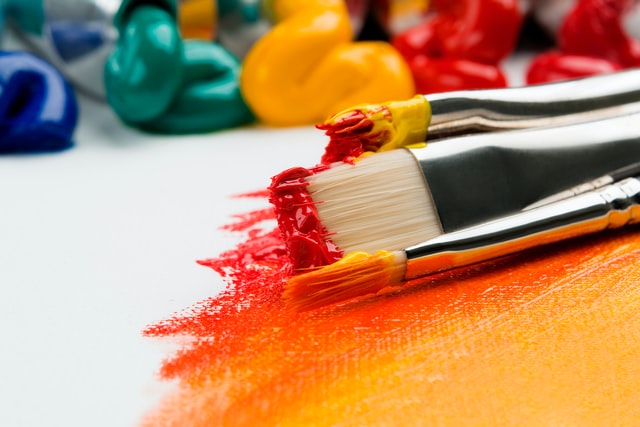
Stay connected.
Sign up to our newsletter for updates on new arrivals and exhibitions


